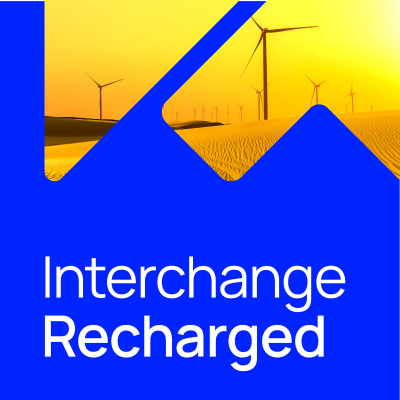
Interchange Recharged
Engels
Business
Tijdelijke aanbieding
1 maand voor € 1
Daarna € 9,99 / maandElk moment opzegbaar.
- 20 uur luisterboeken / maand
- Podcasts die je alleen op Podimo hoort
- Gratis podcasts
Over Interchange Recharged
Clean tech, green finance and energy innovation are the three lanes on the road to a successful global energy transition. At the intersection of these lanes is a place where ideas on finance, technology and policy are shared and debated. That intersection is Interchange Recharged.While Sylvia Leyva Martinez, principal analyst at Wood Mackenzie, is on maternity leave, Bridget van Dorsten, a principal analyst on Wood Mackenzie's hydrogen team, will be hosting this podcast, Interchange Recharged. When Bridget is not researching global market dynamics to craft near and long-term forecasts for low-carbon hydrogen and its derivatives she is speaking with visionaries, entrepreneurs, policy-makers and energy analysts to explore the newest developments in renewable technology, explain the ideas on global energy policy that could accelerate the energy transition, and identify new funding and financial models that could solve the biggest challenges we face on the way to net zero.Bridget and her guests bring you data and forecasts on clean technology, climate science, and offer predictions on the build out of utility-scale projects and the future of green finance.What impacts do the annual UN Conference of the Parties have on decarbonisation goals and climate change? What will COP30 bring? What’s happening in global EV adoption and development? What’s the forecast for solar energy, one of the major success stories of renewable energy in the last ten years? What does the data tell us about the future of hydrogen, of nuclear, or of low-carbon power? These are examples of the insights and detailed analyses you can expect bi-weekly on Tuesdays at 7am ET.If you like The Energy Transition Show, Catalyst with Shayle Kann, The Big Switch from Columbia University, Open Circuit with Jigar Shah or The Green Blueprint, you’ll enjoy Interchange Recharged. Want to get involved with the show? Reach out to podcasts@woodmac.com to: Bring Bridget and Interchange Recharged to your event Be a guest on the show Sponsor an episode Ask a question to Bridget or one of our guests Check out another leading clean tech global podcast by Wood Mackenzie, Energy Gang, at woodmac.com/podcasts/the-energy-gang Wood Mackenzie is the leading global data and analytics solutions provider for renewables, energy and natural resources. Learn more about Wood Mackenzie on the official website: https://www.woodmac.com/
Alle afleveringen
336 afleveringenHow are key renewable energies faring at the end of 2025? Guest host and energy analyst Bridget van Dorsten talks through developments in geothermal, hydrogen and wind.
At the start of the year things were looking uncertain for nascent renewables like hydrogen and geothermal. With policy support from the previous US administration they had boomed with the IRA, then came July 2025 and the Trump administration’s One Big Beautiful Bill, which tore up tax credits and removed incentives for those renewable technologies. As we approach the end of the year, has anything changed for the better? How are hydrogen, wind and geothermal looking as we prepare for 2026? Regular host Sylvia Leyva Martinez is on maternity leave until the middle of next year, so her fellow energy analyst Bridget van Dorsten is stepping up to keep the mic warm. Bridget is an analyst researching hydrogen, but she has an engineer’s understanding of technologies across the energy spectrum. She doesn’t just cover that ‘frustrating, inefficient, expensive-to-move-around molecule’ (as she calls it); she knows what’s real in the energy world and what’s just hype. To kick off her tenure as host she’s picked out a few highlights from the year relating to those important renewables – geothermal, hydrogen and wind. Looking back on those conversations Sylvia had with experts on those fields, Bridget then gives the energy analyst’s view on how things are progressing in the current policy environment. Expect in-depth analysis on what’s changed, and the key stats and forecasts you need to know as 2026 approaches. Plus, Bridget looks back on the conversation Sylvia had with energy investors back in July, when we saw the oil and gas majors like Shell and Equinor announce they were scaling back their climate ambitions under pressure from investors. Bridget explores why the energy transition is unfolding slower than expected, how shareholder pressure is reshaping low-carbon strategies, and why companies like TotalEnergies and Shell have retreated from their plans to phase down fossil fuels. Bridget will be hosting until mid-next-year, and she wants to know what topics you want explored. Connect with the show and let us know what you want to hear, on LinkedIn, X or Bluesky at @interchangeshow, and follow the podcast so you don’t miss the episodes coming in the new year. See Privacy Policy at https://art19.com/privacy [https://art19.com/privacy] and California Privacy Notice at https://art19.com/privacy#do-not-sell-my-info [https://art19.com/privacy#do-not-sell-my-info].
Energy policy, technology, and utility challenges: How industry leaders are overcoming barriers
Utility-scale clean energy projects in development are still facing connection queues and regulatory barriers. RE+ may be done for 2025, but the debate is still going. Host Sylvia Leyva Martinez, Research Director at Wood Mackenzie, sits down with three leaders who are driving progress from different corners of the energy transition, from utility-scale project development to digital grid optimisation and solar system reliability. Sylvia Leyva Martinez and her guests discuss how federal and state regulations shape project timelines and financing, the latest innovations in the grid and the future of interconnection studies, the supply chain outlook for developers and technology providers, and how policy and software are converging to accelerate the energy transition. In this episode you’ll hear from: Angela Amos from AES Clean Energy - As Director of Commercial Strategy & Innovation, Angela brings a unique vantage point that bridges policy, finance, and market execution. Drawing on her experience at AES, Uplight, and FERC, Angela shares how developers are navigating an evolving regulatory landscape, adapting to federal and state policy shifts, and rethinking how technology integration shapes long-term strategy. She also discusses how AES is approaching supply chain partnerships and what “innovation” really looks like at a global energy developer. Lindsey Williams from Shoals Technologies Group - Lindsey is VP of Marketing & Communications at Shoals, and she joins Sylvia to unpack the latest in solar and storage performance. Building on Shoals’ recent focus on EBOS (Electrical Balance of System), Lindsey reflects on how component design, reliability, and digital monitoring are redefining project outcomes. She also shares what she heard from the floor at RE+, including the big industry talking points shaping developer confidence and long-term investment certainty in clean energy infrastructure. Inalvis Alvarez Fernandez from Simple Thread - Inalvis is a Senior Energy Technology Engineer at Simple Thread, and she explains how digital tools like Minerva are helping reduce project backlogs, streamline utility processes, and unlock grid capacity faster. Inalvis also discusses the challenges clean energy companies face scaling renewables and how regulatory clarity can enable more efficient technology deployment. See Privacy Policy at https://art19.com/privacy [https://art19.com/privacy] and California Privacy Notice at https://art19.com/privacy#do-not-sell-my-info [https://art19.com/privacy#do-not-sell-my-info].
Will energy storage save the grid? How batteries and the software behind them are reshaping reliability in the age of AI demand
Electrification is surging, AI data centres are multiplying, and volatility is rising on both sides of the meter. Can storage step in as the flexible backbone the US grid now needs? Host Sylvia Leyva Martinez is joined by Joanna Martin Ziegenfuss, General Manager for Strategic Market Development (North America), and Ruchira Shah, General Manager of Software Product Management at Wärtsilä Energy Storage. Together they unpack how high-performance hardware paired with sophisticated control software delivers real-time flexibility, from synthetic inertia and fast frequency response to price arbitrage and microgrid operation. The conversation tracks the shift from treating storage as a bolt-on to renewables to viewing it as a core reliability asset. Sylvia, Joanna and Ruchi explore how AI-driven load growth and volatile demand profiles change planning assumptions; why interconnection queues are pushing some data centres toward on-site generation plus batteries; and how market rules and policy must evolve to reward flexibility and sub-second response. They also dig into software’s role in future-proofing assets as grid requirements tighten, and where innovators are already meeting new performance thresholds. If you’re navigating project economics, market design or grid operations in a fast-changing landscape, this episode offers a pragmatic look at what’s working, what’s missing, and why storage is set to anchor a resilient, decarbonised grid. This episode is brought to you by Wärtsilä Energy Storage – Wärtsilä delivers high performing, large-scale energy storage systems by combining sophisticated software, robust safety, and long‑term reliability—empowering utility, IPP, and data center customers to maximize energy value and investment returns. To learn more, visit: https://www.wartsila.com/energy/energy-storage?utm_source=woodmac&utm_medium=podcast&utm_campaign=energy_storage_saving_the_grid&utm_content=host [https://urldefense.com/v3/__https:/www.wartsila.com/energy/energy-storage?utm_source=woodmac&utm_medium=podcast&utm_campaign=energy_storage_saving_the_grid&utm_content=host__;!!K61u_eNLIYw!TVT4kr0AqwSJU47S-OUi1bt0lpeV3h8ua_VhbxSaxa9R9ahVwjCPE7U72tEseTHDFUnpijSFQge81dRO55UB_VUf9g$] See Privacy Policy at https://art19.com/privacy [https://art19.com/privacy] and California Privacy Notice at https://art19.com/privacy#do-not-sell-my-info [https://art19.com/privacy#do-not-sell-my-info].
How energy diversification can drive development | Special pre-ADIPEC preview episode
As global energy systems evolve, emerging economies face a defining challenge: how to secure affordable power for today while investing in the low-carbon solutions that will drive tomorrow’s growth. Can energy diversification unlock a new era of industrial development, resilience, and inclusive prosperity? In the third and final episode of our special series ahead of ADIPEC 2025, host Ed Crooks is joined by Charlotte Wolff-Bye, Group Chief Sustainability Officer at PETRONAS, and Andrew Smart, Senior Managing Director at Accenture. Together, they explore how countries in Asia, the Middle East and beyond are using integrated energy strategies to build stronger, fairer economies. Charlotte explains how PETRONAS is redefining its role as a national energy company: supporting Malaysia’s growth through lower-carbon development, capacity-building, and nature-based solutions. She outlines how the company’s investments in renewables, hydrogen, and carbon capture are creating skilled jobs, building local supply chains, and delivering a “just transition” that lifts communities. Andrew shares Accenture’s perspective from the Middle East, where nations are emerging as pivotal connectors between the Global North and South-linking capital, technology, and opportunity. He discusses how digital innovation, AI, and regional interconnection are reshaping resilience and competitiveness, while new financing and regulatory models aim to make clean-energy investment bankable at scale. The message from emerging economies is clear: energy transition and economic development can must advance hand-in-hand. Finally, the group considers what a decade of progress might bring us, including more collaborations across borders and across sectors. They explain why new connections such as regional power grids, diversified supplies, and joined-up policies and corporate strategies point to brighter futures for energy and human development. This is the third and final special episode sponsored by ADIPEC 2025, where the theme is Energy Intelligence Impact. The event brings together 205,000+ attendees and 1,800+ speakers in Abu Dhabi from 3–6 November 2025. The Energy Gang will be recording live at the event. Join us there to be part of the conversation. Learn more and register at adipec.com [https://adipec.com]. See Privacy Policy at https://art19.com/privacy [https://art19.com/privacy] and California Privacy Notice at https://art19.com/privacy#do-not-sell-my-info [https://art19.com/privacy#do-not-sell-my-info].
From capture to storage: inside the full CCUS value chain | Recorded live at CCUS in Houston
This special wrap-up episode of Interchange Recharged takes listeners on a fast tour of the entire carbon capture value chain, from industrial emitters and LNG developers to UK transport and storage pioneers. Host Sylvia Leyva Martinez, Research Director at Wood Mackenzie, brings together three leaders shaping how CCUS moves from theory to reality. First, James Lopez, Subsurface CO₂ Storage Advisor at CEMEX, explains why cement’s process emissions make it one of the hardest sectors to decarbonise and why storage certainty is now the key enabler for investment. He shares how CEMEX is identifying and evaluating CO₂ storage hubs across global sites, and why capture without a permitted storage solution is a business risk few emitters can take. “CCUS doesn’t work if you only have the C,” he says, “you need the full chain.” Next, Glenn Wilson, Chief Financial Officer at Coastal Bend LNG, discusses how LNG economics and carbon capture can work hand in hand. Designed from day one as a low-carbon project, Coastal Bend LNG is integrating capture across both pre-treatment and post-combustion stages, aiming for near-zero emissions. Glenn explains how 45Q tax credits and the sale of verified environmental attributes create a dual-revenue model, and why tokenising the carbon intensity of each LNG cargo could redefine transparency in global energy trade. “We’re not just reducing emissions,” he says, “we’re creating a new market for verified carbon value.” Finally, Nick Terrell, Executive Director at Carbon Catalyst, joins from the UK to reveal how depleted gas fields are being repurposed into next-generation carbon storage sites. Following the country’s first offshore CO₂ injection test, he shares how reusing North Sea infrastructure is cutting costs, driving bankability, and opening the door to cross-border storage for European emitters. As policy alignment grows between the UK and EU, Terrell argues that liberalisation and private capital will be the next accelerators. “Once we have more FIDs,” he says, “finance, technology, and data will do the rest.” From the cement kiln to the seabed, this episode captures the energy and optimism emerging across the CCUS ecosystem - a clear sign that carbon capture is moving from cautious planning to confident execution. See Privacy Policy at https://art19.com/privacy [https://art19.com/privacy] and California Privacy Notice at https://art19.com/privacy#do-not-sell-my-info [https://art19.com/privacy#do-not-sell-my-info].
Kies je abonnement
Tijdelijke aanbieding
Premium
20 uur aan luisterboeken
Podcasts die je alleen op Podimo hoort
Gratis podcasts
Elk moment opzegbaar
1 maand voor € 1
Daarna € 9,99 / maand
Premium Plus
Onbeperkt luisterboeken
Podcasts die je alleen op Podimo hoort
Gratis podcasts
Elk moment opzegbaar
Probeer 30 dagen gratis
Daarna € 11,99 / month
1 maand voor € 1. Daarna € 9,99 / maand. Elk moment opzegbaar.

































